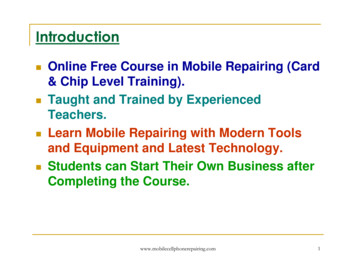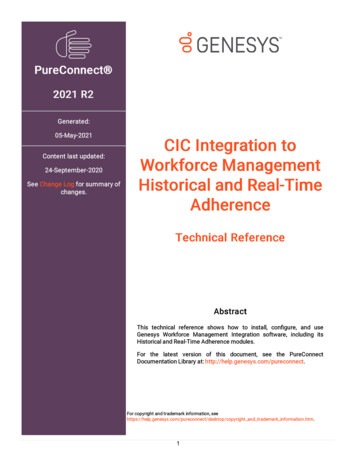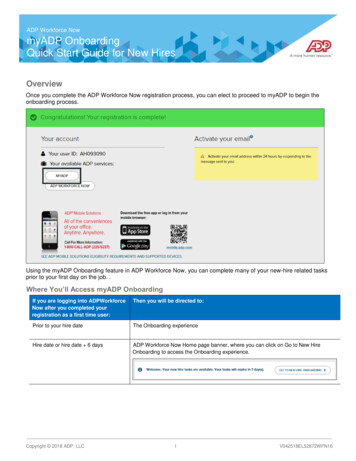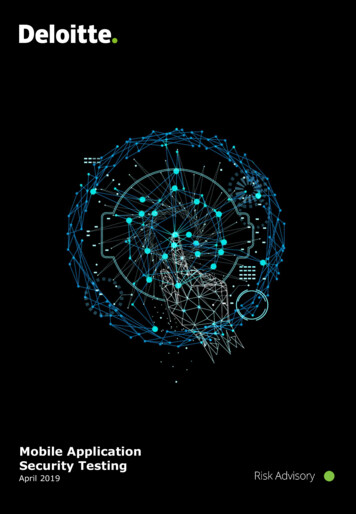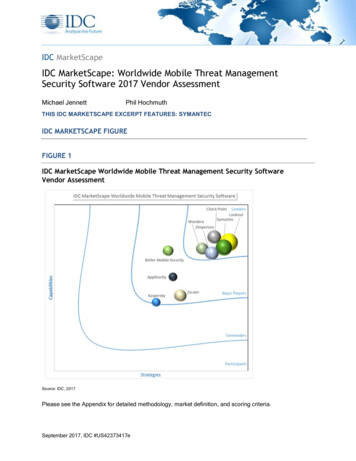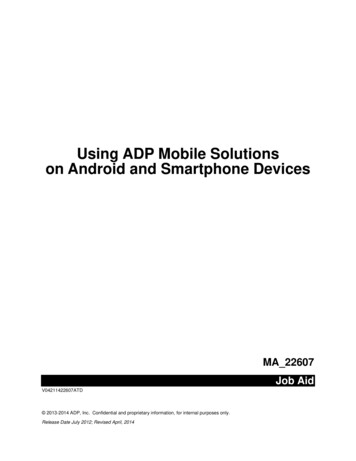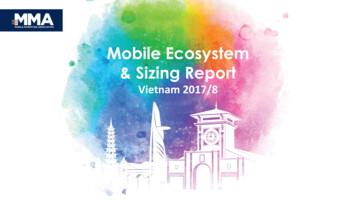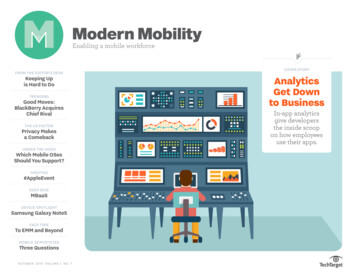
Transcription
MMFrom The Editor’s DeskKeeping Upis Hard to DoTrendingGood Moves:BlackBerry AcquiresChief Rivalthe ux factorPrivacy Makesa ComebackUnder the HoodWhich Mobile OSesShould You Support?Hashtag#AppleEventDeep DiveMBaaSDevice SpotlightSamsung Galaxy Note5Face TimeTo EMM and BeyondMobile DemystifiedThree Questionsoctober 2015 volume 1, no. 7Modern MobilityEnabling a mobile workforcecover storyAnalyticsGet Downto BusinessIn-app analyticsgive developersthe inside scoopon how employeesuse their apps.
From The Editor’s Desk Alyssa WoodKeeping Upis Hard to DoHomeKeeping Up is Hard to DoIn-App Analytics GetDown to BusinessGood Moves: BlackBerryAcquires Chief RivalPrivacy Makes aComebackWhich Mobile OSesShould You Support?#AppleEventMobile Backendas a ServiceSamsung Galaxy Note5To EMM and BeyondThree Burning QuestionsIt’s been an action-packed few months in themobile world. Just a few days after returningfrom VMworld, I saw my Twitter feed blow upwith the news of BlackBerry’s acquisition ofGood Technology. The following week, Applemade headlines with the iPhone 6s, iPad Proand more. And most importantly, at least ifyou’re a steadfast member of New EnglandPatriots Nation like myself: the glorious vindication of one Tom Brady. (OK, that’s not reallytechnology news, but there’s a lesson somewhere in there about what not to store on yourcellphone.)All these developments got me thinkingabout the rate of technological change intoday’s world.It’s been well-documented that productadoption today moves much faster than it dideven 20 years ago. Cars and electricity tooknearly a century to reach 90% of U.S. households, but newer technology like color TVsand dishwashers—and later, computers and theInternet—were in the hands of most consumersjust a few decades after they became available.Look at mobility, for instance: It took landlinephones about 45 years to penetrate half of U.S.Product adoption todaymoves much faster than itdid even 20 years ago.households, while mobile phones took onlyseven years to hit that mark, according to MITTechnology Review.With vendors such as VMware, Microsoft,BlackBerry and Apple continuing to push theboundaries of what they can innovate—andhow quickly they can do it—it feels like we’reon the cusp of generating even faster technological change.modern MOBILITYoctober 20152
HomeKeeping Up is Hard to DoVMware’s unified hybrid cloud platformpromises to connect public and private cloudand on-premises resources to help delivermore apps than ever. Microsoft appears tohave struck a balance between traditionaldesktop computing and mobility with Windows 10. With Good under its belt, BlackBerryhas an opportunity to strengthen its management and security capabilities for all the majormobile operating systems.The enterprise mobility management market will likely see further consolidation, andthe technology will have to handle more thanjust smartphones and tablets. The Internetof Things is coming. Finally, with an updatedApple Watch OS, photos that can move and itspotentially revolutionary 3D Touch technology, Apple is changing the consumer devicegame yet again.All these announcements mean moredevices will be entering the workplace, andto help manage them, admins will have moretools at their disposal than ever. IT will have tobe ready—and fast. lIn-App Analytics GetDown to BusinessGood Moves: BlackBerryAcquires Chief RivalPrivacy Makes aComebackWhich Mobile OSesShould You Support?#AppleEventMobile Backendas a ServiceSamsung Galaxy Note5To EMM and BeyondThree Burning Questionsmodern MOBILITYoctober 20153
In-AppAnalytics GetDown toBusinessmobility nowEmerging analytics tools providenew insights about mobile appusage. The hard part is figuringout what to do with all thatinformation. Colin SteeleHomeKeeping Up is Hard to DoIn-App Analytics GetDown to BusinessGood Moves: BlackBerryAcquires Chief RivalPrivacy Makes aComebackWhich Mobile OSesShould You Support?Analytics drive business today. They#AppleEventgive organizations the information theyneed to determine whether products andcampaigns are successful—and how to fixthem if they’re not. They identify inefficiencies in business processes and potential solutions. And they even factor intosome personnel decisions.Mobile Backendas a ServiceSamsung Galaxy Note5To EMM and BeyondThree Burning QuestionsCredit: enotmaks/iStockmodern MOBILITYoctober 20154
HomeKeeping Up is Hard to DoIn-App Analytics GetDown to BusinessGood Moves: BlackBerryAcquires Chief RivalIncreasingly, analytics are also built intoenterprise mobile applications, where theyoffer invaluable data about the user experience. How many button taps does it take toperform a certain task? What specific actioncaused the app to crash? Which features dousers ignore, and why? In-app analytics canprovide the answers to all these questions andmore.With this insight, developers and operationsstaff can streamline app workflows, improveback-end performance and identify bugs andpoor design components. But the abundanceof data to collect and analyze can overwhelmsome organizations and limit the benefits ofthis emerging technology.Privacy Makes aComebackWhich Mobile OSesShould You Support?#AppleEventMobile Backendas a ServiceSamsung Galaxy Note5To EMM and BeyondThree Burning QuestionsA More Complete PictureApplication performance monitoring(APM)—a mainstream technology that measures an application’s resource utilization,network latency and other factors to ensure anacceptable user experience—is nothing new.It’s also standard practice for developers totest the performance and user experience oftheir applications. Traditionally, however, thistesting takes place before IT deploys an app,and in a controlled environment with a subset of users. But in the mobile era, it would benearly impossible to test an app on every possible device and operating system combination a user could have. Consequently, the datagathered during mobile app testing doesn’talways reflect what will happen when an appgoes into production.“ In-app analytics are criticalto application lifecyclemanagement. You’re alwaysgoing to be iterating.” —Philippe Winthrop, CSC“You can only test so much,” said JasonWong, principal research analyst at Gartner.That’s where in-app analytics come in. Realtime data from workers who are using the appto perform real business tasks offers a morecomplete picture—and more actionable intelligence—than APM and app testing alone.“In-app analytics are critical to applicationlifecycle management,” said Philippe Winthrop, global mobility evangelist at CSC, an ITservices provider. “There is no such thing asversion one-and-done of an enterprise mobilemodern MOBILITYoctober 20155
HomeKeeping Up is Hard to DoIn-App Analytics GetDown to BusinessGood Moves: BlackBerryAcquires Chief RivalPrivacy Makes aComebackWhich Mobile OSesShould You Support?#AppleEventMobile Backendas a ServiceSamsung Galaxy Note5To EMM and BeyondThree Burning Questionsapp. You’re always going to be iterating.”Consider this hypothetical example: Basicapp analytics report that a certain app crashes10% of the time, typically about 15 secondsafter it’s opened. In this scenario, the developer would have to go into the app’s code,try to figure out where in its workflow a userwould be after 15 seconds and identify a bugthat could be causing the crash. In-app analytics, on the other hand, would report thatthe crashes occur when users press the AddNew Customer button on one of the app’s submenus. And the developer would know exactlywhich part of the code to fix.Some analytics tools can even record users’sessions in an app to identify problems thataren’t related to code. Wong shared oneexample in which users weren’t completinga workflow, and they were all abandoningthe app at the exact same point. Recordingsshowed that users pinched and zoomed ontheir touchscreens at that point to more clearlysee numbers they needed to enter. But therewas a button they needed to press to confirmtheir entries on that screen, and it disappearedwhen they zoomed in, making it look like theapp had frozen.That’s what caused users to give up on theapp, but traditional analytics wouldn’t havepicked up on it.“From an APM perspective, it all lookedfine,” Wong said.Analyzing the Analytics MarketThere is no shortage of vendors who offerin-app analytics capabilities. Emerging vendors such as Localytics, Crittercism, Appseeand Twitter’s Crashlytics focus primarily onthis area; Adobe, IBM and others make in-appanalytics part of their broader enterprisemobility offerings.Kony, a mobile application developmentvendor based in Austin, Texas, got into thegame last year when it released its mobilebackend as a service platform, Mobile Fabric.In-app event tracking capabilities are bakedinto Mobile Fabric’s software development kit,so developers can access analytics for any oftheir apps that tie into the service, regardlessof what development platform they use.“Customers are increasingly wanting tochoose their own front-end tools,” said Burley Kawasaki, Kony’s senior vice president ofplatforms.Despite the plethora of vendors in themodern MOBILITYoctober 20156
Homemarket and the promise of in-app analytics,the technology isn’t always an easy sell. CSCencourages its customers to implement itspartners’ analytics tools, but those who do arein the minority, Winthrop said.“Part of that is cost,” he said. “Part of that isunderstanding the real benefits.”Indeed, developers may not realize theimportance of in-app analytics until afterthey’ve built and deployed an app.Keeping Up is Hard to DoIn-App Analytics GetDown to BusinessIn-app analytics are an importantcomponent of mobile DevOps.Good Moves: BlackBerryAcquires Chief RivalPrivacy Makes aComebackWhich Mobile OSesShould You Support?#AppleEventMobile Backendas a ServiceSamsung Galaxy Note5To EMM and BeyondThree Burning Questions“There is this maturity process that customers go through,” Kawasaki said. “Often timesthey’re just trying to get the first app out. Sothey’re not always asking for [analytics].”The inflection point usually comes whenorganizations find themselves with a dozen ormore apps, and monitoring them individuallybecomes a hardship, Wong said. Mobile appupdates should ideally come every one to twomonths, and in-app analytics can help prioritize which apps to fix, fine-tune and upgradewithin that timeframe, he said.The Hard PartStill, organizations that adopt in-app analytics often struggle to make the best use of thetechnology. For example, analytics may showthan an app’s response time for a certain actionis a fraction of a second longer than it shouldbe—a traditional metric. Meanwhile, the analytics may also show that it takes twice as longas it should for a user to process an order in acustomer relationship management app. That’sa more business-critical problem, but it’s alsomore challenging to fix because it requires arethinking of processes and workflows.“It’s the continuous improving of the appthat’s the hard part,” Kawasaki said.To step up to this challenge, in-app analyticscustomers should take a big-picture view: Recognize that the data is important, but understand what it means, Winthrop said. Thatrequires a new mindset, and it takes a lot ofwork—but so does developing an applicationin the first place.“If you’re going to build an app,” Winthropsaid, “don’t you want to know how it’s performing?” lColin Steele is editor in chief of Modern Mobility. Followhim on Twitter: @colinsteele.modern MOBILITYoctober 20157
Trending Colin SteeleHomeKeeping Up is Hard to DoIn-App Analytics GetDown to BusinessGood Moves: BlackBerryAcquires Chief RivalPrivacy Makes aComebackWhich Mobile OSesShould You Support?#AppleEventMobile Backendas a ServiceSamsung Galaxy Note5To EMM and BeyondThree Burning QuestionsGood Moves:BlackBerryAcquires ChiefRivalBlackBerry claws its way to thetop with a well-timed EMM buy.As BlackBerry’s smartphone business plum-meted over the years, the company tried toreinvent itself in the cross-platform EMMmarket. Things didn’t go so well.Despite the strong security technologybuilt into BlackBerry Enterprise Service,businesses never really bought into it as atool for managing Apple iOS and GoogleAndroid devices. To get over that hump,BlackBerry went out and bought GoodTechnology—an established cross-platformenterprise mobility management (EMM)Photograph: johncatral/flickrBlackBerryBoldvendor—for 425 million last month. Theacquisition gives BlackBerry a major boost inmarket share, but it may not help the companyexpand beyond its security-conscious customer base.With Good in the fold, BlackBerry will havesignificantly more EMM market share thanany other vendor, according to a June reportby IDC: 19.2%, compared to second-place AirWatch by VMware’s 11.4%. If BlackBerry canmaintain or grow this lead post-acquisition,it will have gotten a steal of a deal. VMwarebought AirWatch in 2014 for 1.54 billion—over 1 billion more than what BlackBerry paid forGood.modern MOBILITYoctober 20158
HomeKeeping Up is Hard to DoIn-App Analytics GetDown to BusinessGood Moves: BlackBerryAcquires Chief RivalPrivacy Makes aComebackWhich Mobile OSesShould You Support?#AppleEventMobile Backendas a ServiceSamsung Galaxy Note5To EMM and BeyondThree Burning QuestionsA Once-Bitter RivalryBlackBerry and Good have an interesting history. They had a fairly heated marketing warlast year, in which BlackBerry accused Goodof misleadingly comparing its new productsto older, outdated versions of BlackBerry’sproducts.The vendors also regularly competed forcustomers in highly regulated industries,such as finance and law, as well as federalagencies. BlackBerry’s encrypted network anddevices made it the default choice in thosesectors for years. Good’s secure containersprovided an application-level alternative—especially for email, which had long beenBlackBerry’s bread and butter. Good also hadmore success with the iOS and Android crowd,which provided a boost as the BYOD trendtook hold.Now the former rivals have buried thehatchet. BlackBerry CEO John Chen complimented Good’s container technology duringa conference call announcing the acquisition,and Good CEO Christy Wyatt had only positive things to say about BlackBerry’s securityexpertise in a blog post she wrote.With this acquisition, the era of standalonevendors leading the EMM market appears toEMM Market 33%Source: IDC, “Worldwide Enterprise Mobility ManagementSoftware Market Shares, 2014,” June 2015.be winding down. Good, AirWatch, Zenprise,Fiberlink and Sybase are all part of larger companies that do more than just manage mobiledevices and applications. MobileIron remainsthe lone holdout among the traditional marketheavyweights. lColin Steele is editor in chief of Modern Mobility. Followhim on Twitter: @colinsteele.modern MOBILITYoctober 20159
The UX Factor Steve DamadeoHomeKeeping Up is Hard to DoIn-App Analytics GetDown to BusinessGood Moves: BlackBerryAcquires Chief RivalPrivacy Makes aComebackWhich Mobile OSesShould You Support?#AppleEventMobile Backendas a ServiceSamsung Galaxy Note5To EMM and BeyondThree Burning QuestionsPrivacy Makesa ComebackNext-generation mobile workers won’tlet IT invade their personal lives—evenif it’s in the name of security.Privacy is dead. Think about how often you’veheard that phrase in the last 12 months. Even I,a representative of the millennial generationthat scoffs at privacy in favor of convenienceand access to information, have said it. Sowhat if a store I frequent spams my phone withoffers and reminders the moment I walk in? Idon’t care, because it makes my life easier.As it turns out, privacy isn’t dead. I just forgot how much I enjoyed mine.I recently attended Nemertes Research’sNavigator 360 conference, and one of the panels talked about how millennials are no longerIdentity accessmanagement essentiallygives people the feelingthat business is businessand personal is personal.the up-and-coming generation. Now it is thecentennials—current high school students,born after the turn of the century, who will beentering college and the workforce soon. Andone of the biggest differences with centennialsis they actually care about privacy. So whatdoes this mean for mobile technology goingforward?Like millennials, centennials are a mobilefirst generation that largely grew up with ubiquitous connectivity. But they also grew up withWikileaks and Edward Snowden, and they haveseen firsthand what happens when privacy isan afterthought, including the damage it cando personally, economically and politically. Forcentennials, nothing trumps privacy, not evenconvenience.IT needs to care about privacy because ourusers do. There is a heightened sensitivity surrounding surveillance and how informationmodern MOBILITYoctober 201510
HomeKeeping Up is Hard to DoIn-App Analytics GetDown to BusinessGood Moves: BlackBerryAcquires Chief RivalPrivacy Makes aComebackWhich Mobile OSesShould You Support?#AppleEventMobile Backendas a ServiceSamsung Galaxy Note5is used. But corporate IT usually immediately leads its policies with “people shouldhave no expectation of privacy.” Companiesshould respect the privacy of their employeesin the same way they are required to of theircustomers.So what can enterprise mobility practitioners do about this? Luckily, we’re starting tosee more discussions and even new productsaround how to ensure privacy. A hot topic inmobility now is identity access management(IAM), and organizations that aren’t yet looking at it really need to start.IAM essentially gives people the feeling thatbusiness is business and personal is personal.It authenticates users’ identities and authorizes access to specific applications and datastores, ensuring that only the people permittedto access certain systems are able to do so.IAM can also help keep IT out. Whenemployees agree to the organization’s rulesof use, then IT must agree to not touch theirpersonal information or data. For example,the organization’s policy might say that ITcan wipe the corporate information off anemployee’s phone at any time; however, it mayalso say that IT can’t wipe the entire devicewithout that person’s express permission.Enterprise IT needs to have an understanding of what it’s like to be on the other side. Thealmighty security trump card doesn’t mean IThas the right to control users’ personal data.It’s important to separate work and personalso the organization can only have controlover corporate information. That could meanemployees having separate devices, or betteryet, IT implementing containerization or dualpersona technology.With the rise of the centennial generation,many of whom will be replacing baby boomersin all our organizations, we need to addressmobile privacy now. Centennials won’t workfor organizations that don’t respect their privacy, so in the ongoing battle for talent, a lackof a clear privacy policy could be a deathblowfor some companies. lSTEVE DAMADEO is IT operations manager at industrialautomation supplier Festo. Follow him on Twitter:@sdamadeo.To EMM and BeyondThree Burning Questionsmodern MOBILITYoctober 201511
Under the Hood Eric KleinHomeKeeping Up is Hard to DoIn-App Analytics GetDown to BusinessGood Moves: BlackBerryAcquires Chief RivalPrivacy Makes aComebackWhich Mobile OSesShould You Support?#AppleEventMobile Backendas a ServiceSamsung Galaxy Note5To EMM and BeyondThree Burning QuestionsWhich MobileOSes Should YouSupport?When choosing which mobile platformsto approve for work, user-friendlinessisn’t everything.As enterprises begin building and buyingmobile applications, one of their first majordecisions is: which mobile operating systemsto support? Apple iOS and Google Androidare dominating; combined these platformsaccount for roughly 90% of the mobile OSmarket. End users are familiar with these platforms and have made sizeable investments intheir apps, leaving BlackBerry and Windows tolag behind. Still, churn is inevitable, and Microsoft’s strategy to converge the desktop andThe progress Apple and Googlehave made in augmentingtheir security posture has madesupporting these platforms aneasy choice for CIOs and CISOs.mobile user experience will affect the dynamics of the mobile OS market.When it comes to enterprise mobility,securing mobile devices and applications hasbecome a top priority. The prominent handsetmanufacturers targeting the enterprise continue to add key security features that give ITthe peace of mind to include certain smartphones and tablets on the list of approveddevices for work. As more companies gomobile, the onus lies on IT to effectively manage those devices and implement the appropriate security policies.The progress Apple and Google have madein augmenting their security posture hasmade supporting these platforms an easychoice for CIOs and CISOs. But while Apple’swalled garden approach to controlling iOSallows the vendor to dictate the cadence ofOS updates, this is still a sore spot for Android,modern MOBILITYoctober 201512
which is at the mercy of carriers for timelyupdates.HomeKeeping Up is Hard to DoIn-App Analytics GetDown to BusinessGood Moves: BlackBerryAcquires Chief RivalPrivacy Makes aComebackWhich Mobile OSesShould You Support?#AppleEventMobile Backendas a ServiceSamsung Galaxy Note5To EMM and BeyondThree Burning QuestionsApple iOSThe iOS platform features robust, layeredsecurity elements at its core without compromising the user experience. Apple’s use ofhardware-level AES-256 cryptography to provide full-disk encryption and fast remote wipecapability is well known, but the company hasalso implemented other important sandboxingfeatures. Each application is limited in whereit can write data and cannot access other applications’ data or code. To share informationwith other apps, developers need to communicate through APIs or other services. Plus, thecore OS partition is read only, which furtherprevents malicious programs from attackingthe device.A lack of professional services, supportoptions and distribution channels has hindered Apple’s enterprise play, but this ischanging quickly. The company’s partnershipswith IBM and Cisco help give Apple the enterprise inroads it has lacked.In addition, iOS 9 builds on Apple’s enterprise features with hardware-based storageencryption, remote wipe capabilities andcountless device and supervision restrictions.Apple’s APIs provide Touch ID biometricsecurity features to third-party developers, andthe company has implemented passcode capabilities on numerous native applications.Apple’s security enhancements will keepiOS on the top of most lists when IT chooseswhich mobile OSes it will support.BlackBerryBlackBerry has brand strength among certainbusiness users, and its value play continuesto revolve around its best-in-class securitycapabilities and enterprise-grade email andmessaging. The company’s slow move totouchscreens and lack of developer engagement have significantly harmed its marketshare and threatened its longevity, but it hasdemonstrated progress by releasing a smartphone lineup with innovative features.Plus, BlackBerry continues to excel inindustries with rigorous security and compliance mandates such as financial servicesand healthcare. The vendor’s recent acquisition of enterprise mobility management(EMM) provider Good Technology will alsomodern MOBILITYoctober 201513
help, as will its plan to produce Androiddevices, starting with the Priv.HomeKeeping Up is Hard to DoIn-App Analytics GetDown to BusinessGood Moves: BlackBerryAcquires Chief RivalPrivacy Makes aComebackWhich Mobile OSesShould You Support?#AppleEventMobile Backendas a ServiceSamsung Galaxy Note5To EMM and BeyondThree Burning QuestionsAndroidThis year, Google made several importantenterprise mobility announcements. For one,Google Play for Work, the enterprise version of the Google Play app store, will allowcompanies to provide access to enterpriseapplications from secure work containers onemployees’ devices.The Android for Work initiative providesthose containers that separate personal andcorporate data—ensuring secure access tomail, contacts, calendar, browsing and documents. That should help combat the idea thatAndroid lacks security and is therefore aninadequate mobile computing platform forthe enterprise. Still, Android for Work requiresusing a Google-approved third party EMMvendor to manage the corporate profile of adevice. Every tier-one EMM vendor (with theexception of Good) has partnered well withGoogle, but the levels of integration vary.Android 5.0 Lollipop includes securityenhanced (SE) Linux, which serves as a firewall for all applications on a device. SELinuxon Android, known as SE Android, creates anaccess control system that isolates the applications users download so potential malwarecannot access the OS itself.Android 5.1 includes a device protectionmechanism similar to Apple’s that keeps thedevice locked (even after factory reset) untilthe user signs on to the corresponding Google account. This feature adds a much-neededsecurity layer for lost or stolen phones. Themost pertinent security feature in the upcoming Android 6.0 Marshmallow OS is the abilityfor developers to work fingerprint authentication into their applications.Google’s acquisition of Divide in 2014 provided the company with the tools to buildcontainerization, encryption and device management into Android. And with Android forWork, Google can help other Android manufacturers make their devices suitable for enterprise deployment—instead of relying solely onSamsung KNOX to carry that flag. Susceptibility to malware will continue to be an issueCompare iOS and Android forenterprise use.modern MOBILITYoctober 201514
for Android, but Google has provided IT withmore control over device management andprotection, which should increase its share ofthe enterprise market.HomeKeeping Up is Hard to DoIn-App Analytics GetDown to BusinessGood Moves: BlackBerryAcquires Chief RivalPrivacy Makes aComebackWhich Mobile OSesShould You Support?#AppleEventMobile Backendas a ServiceSamsung Galaxy Note5Microsoft WindowsMicrosoft has worked hard to elevate themessaging around its Enterprise MobilitySuite. EMS includes identity and access management for applications through MicrosoftAzure Active Directory Premium, along withencryption and authorization policy enforcement in Azure Rights Management Services.At its core is Microsoft Intune, the cloud-basedEMM platform that helps IT control access tobusiness applications on users’ devices. WithEMS, the key will be to deliver on the valueproposition that Microsoft touts: one vendor,one contract, one SKU.Windows 10 is also critical for the company. In particular, the Windows Hello featureimproves security by allowing users to accessWindows devices via their fingerprint, irisor face. There’s also Passport, a feature thatallows users to access applications, websitesand networks without additional passwordsfollowing verification. Reducing the need forpasswords—which users can inadvertently orpurposely share with others—lowers the probability of a hacker accessing a user’s deviceand information. Windows 10 also adds DeviceGuard, a security enhancement that protectsagainst malware by blocking unapprovedapplications.Don’t Take OS Decisions LightlyChoosing which mobile operating systemsto support involves critical decisions abouthow to best approach device and applicationmanagement, privacy, user agreements andmuch more. These will be high-priority issuesfor years to come, and the growing numberof devices on the market will require organizations to quickly accommodate the myriadmobile OSes coming into the enterprise. lERIC KLEIN is director of mobile software at VDC Researchin Natick, Mass. Follow him on Twitter: @eakleiner.To EMM and BeyondThree Burning Questionsmodern MOBILITYoctober 201515
#AppleEventhashtagTwitter sounds off on Apple’s new tech, the iPad Pro—which looks a lot likea Surface—and the Microsoft exec who was on stage to help launch it.Jeff Cannata@jeffcannataHomeKeeping Up is Hard to DoIn-App Analytics GetDown to BusinessWe made somethingexactly like Microsoftthat will vastly outsellthem. Here to get hisface rubbed in it, is thisguy from Microsoft.Brett Belding@bbeldingI wonder what we’regoing to do with the newApple TV in the enterprise? I’m sure there area pile of use cases.#AppleEventMarty Resnick@mobileologistSeems the iPad Prohas clearly taken somedesign influences fromMicrosoft Surface Proand Samsung Note Pro.#AppleEventGood Moves: BlackBerryAcquires Chief RivalPrivacy Makes aComebackWhich Mobile OSesShould You Support?Eric Beehler@cstechcastMichael Flores@Mike Flores23Wes Miller@getwired#AppleEventMobile Backendas a ServiceSamsung Galaxy Note5To EMM and BeyondApple basically openedwith a new way to pushdevices into enterprise.Watch OS/2.#AppleEvent#AppleWatchWatching yesterday’skeynote. I just got myiPhone two months agoand it already feels outof date. #AppleEventAn actual headline in2015: “Apple seedsfirst iOS 9.1 beta todevelopers, adds newtaco, burrito & unicornemojis.”Three Burning QuestionsmodernmodernMOBILITYMOBILITY octoberoctober 201516
Deep Dive JACK MADDENHomeKeeping Up is Hard to DoIn-App Analytics GetDown to BusinessGood Moves: BlackBerryAcquires Chief RivalPrivacy Makes aComebackWhich Mobile OSesShould You Support?#AppleEventMobile Backendas a ServiceSamsung Galaxy Note5To EMM and BeyondThree Burning QuestionsMobile Backendas a ServiceEnterprise apps can’t functionwithout infrastructure access.MBaaS lends a helping hand.As enterprise mobility strategies becomemore advanced, companies are buildingmore in-house, line-of-business mobileapps—often an expensive and dauntingproposition.There are many technologies available tomake this process easier, including application refactoring, mobile app developmentplatforms and HTML5. Another relativelyrecent addition to the list is mobile backendas a
Kony, a mobile application development vendor based in Austin, Texas, got into the game last year when it released its mobile backend as a service platform, Mobile Fabric. In-app event tracking capabilities are baked into Mobile Fabric’s software devel



